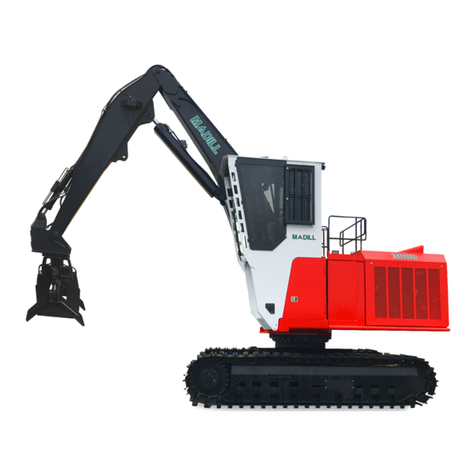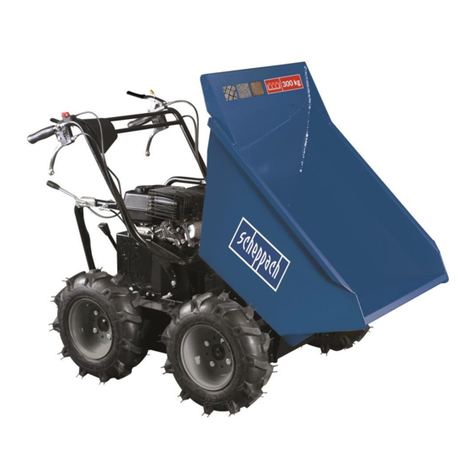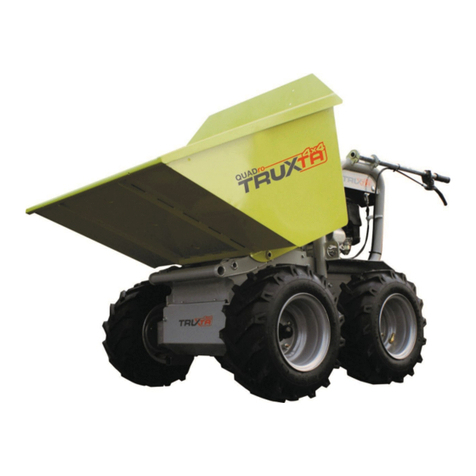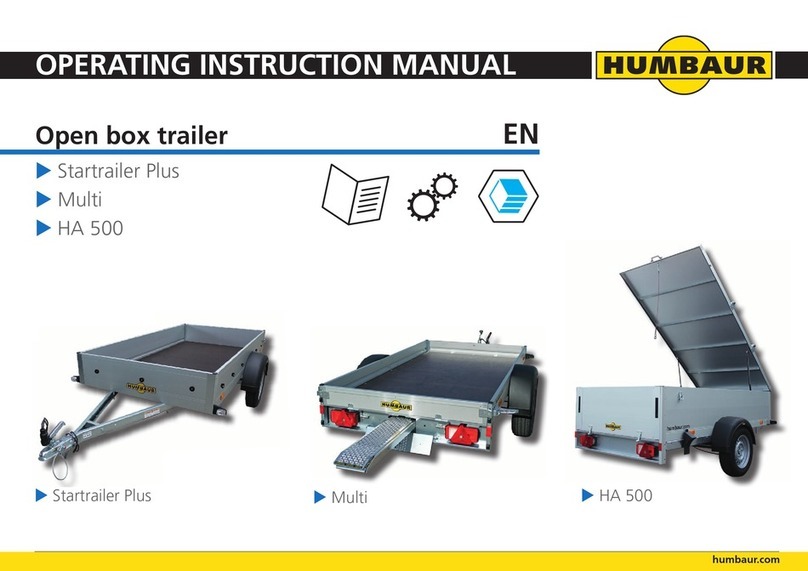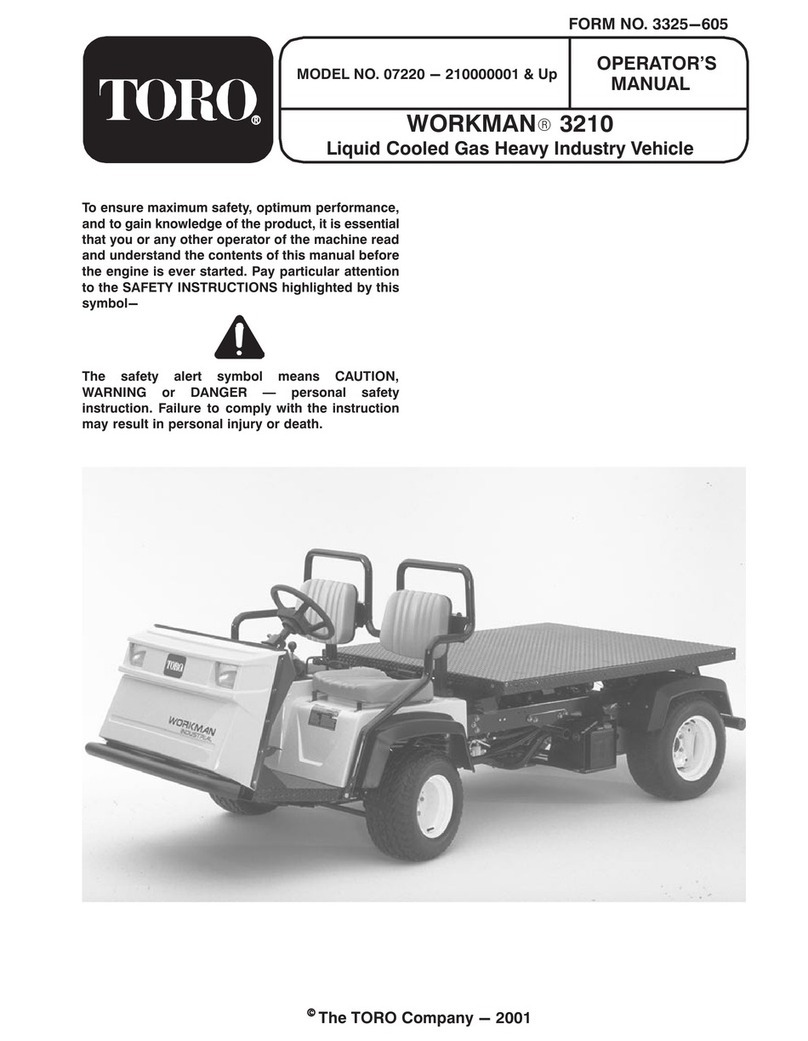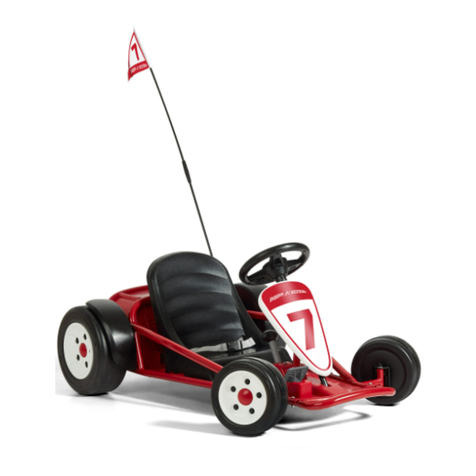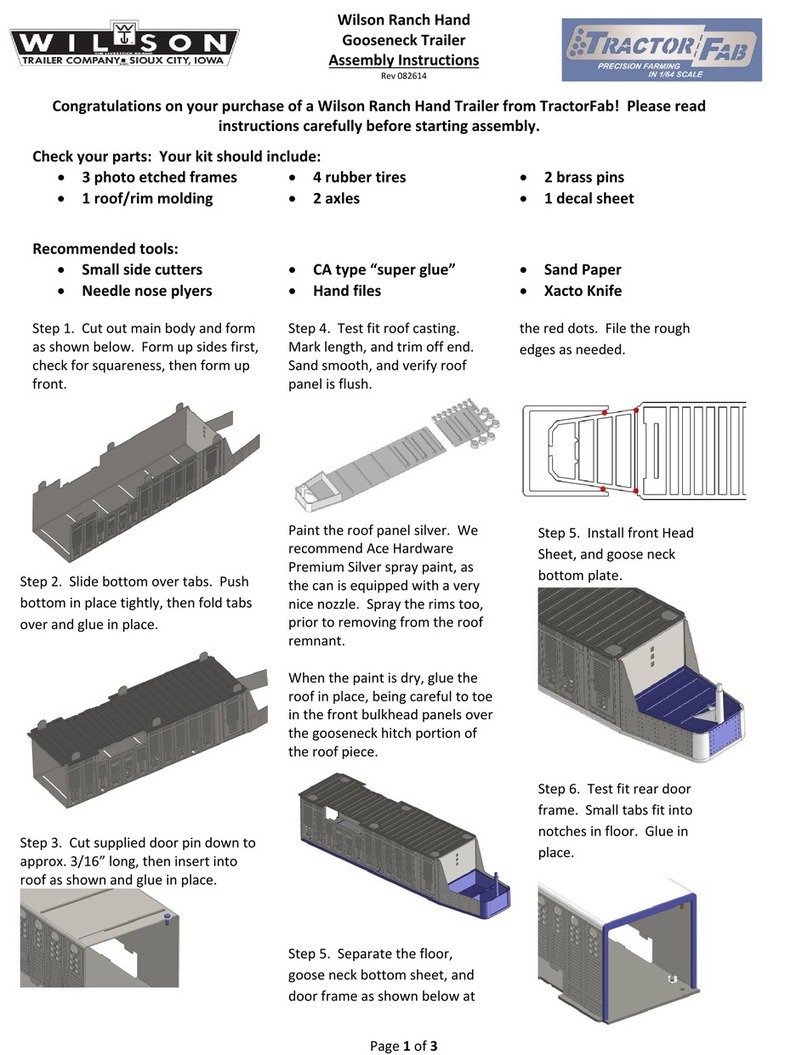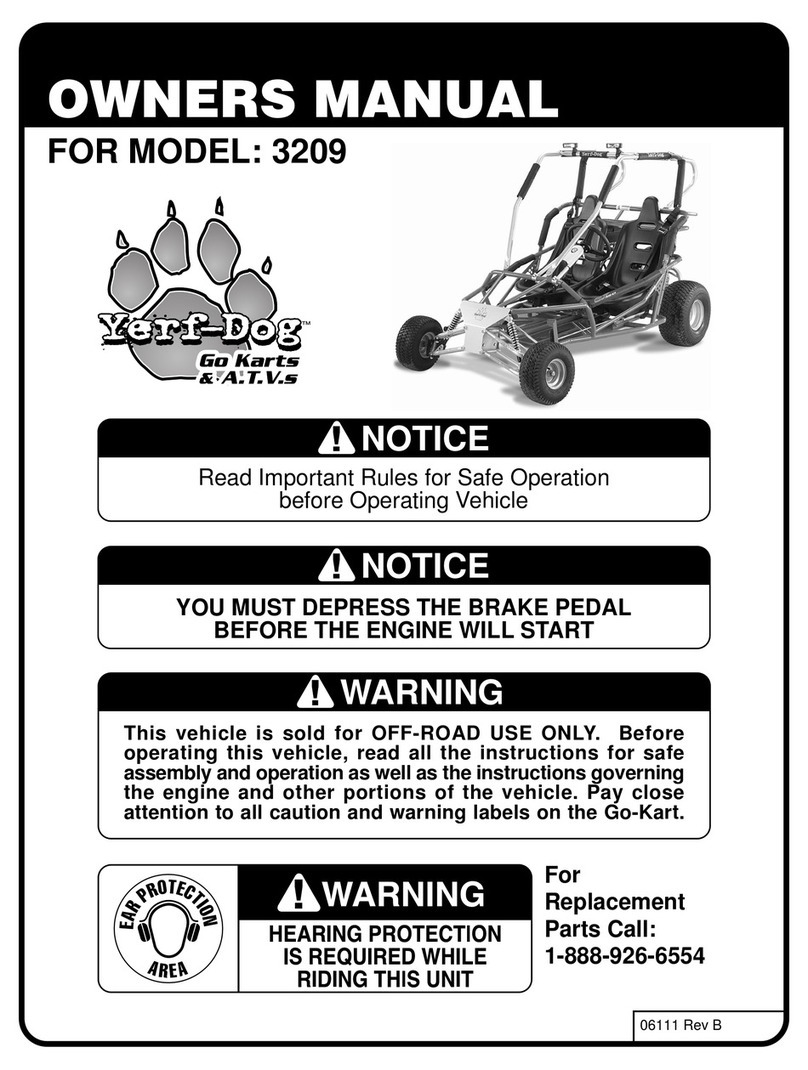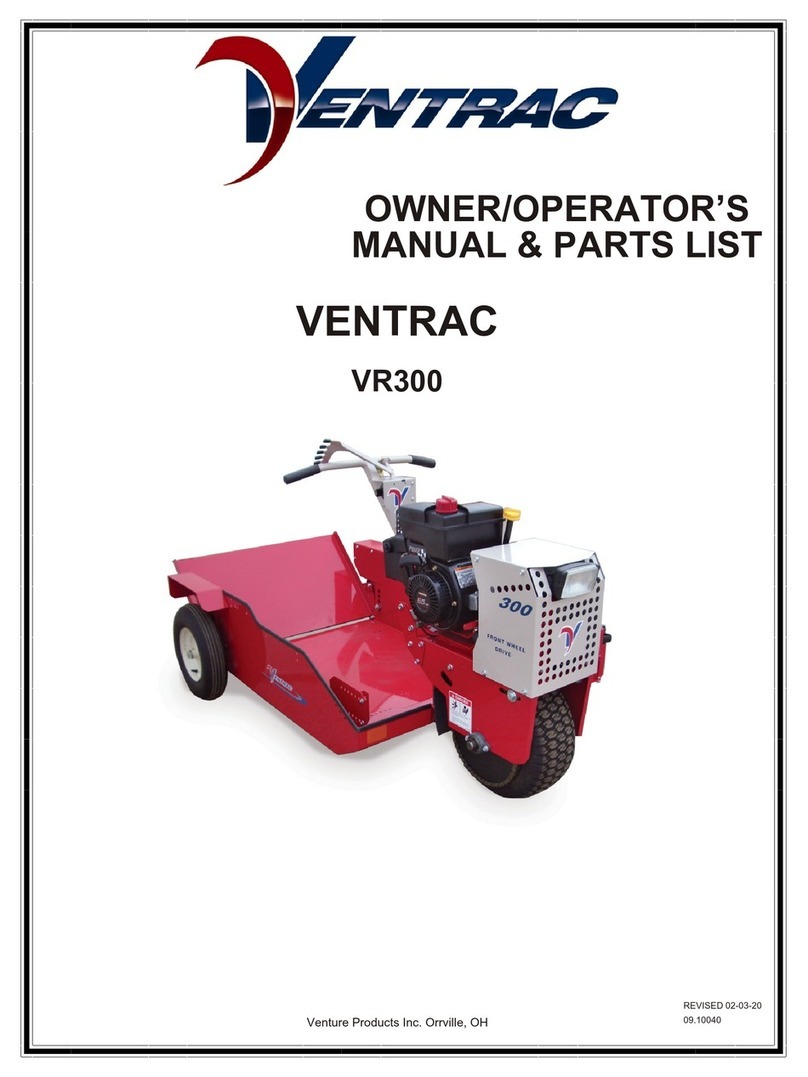Madill 1200 User manual



MADILL 1200
PREFACE
The operating and maintenance manual is designed to familiarize the operator of this
machine with all the necessary information so that he may take full advantage of the
capabilities built into the machine. If the machine is operated and maintained properly, it
will yield profitable results. For this reason, it is imperative that the basic needs of the
machine be satisfied. When the machine is lubricated with the recommended lubricants
at the recommended intervals, abnormal part wear and failures will be avoided. Using
the correct hydraulic oil for the prevailing temperatures and conditions, and careful main-
tenance of the hydraulic oil filters will help ensure a trouble free and dependable hydrau-
lic system.
The maintenance sections of the manual outline repair and replacement procedures
which may be periodically necessary. This covers both mechanical and hydraulic repairs.
When ordering parts, please include the serial number of the machine. Also serviceable
parts will be covered in the parts manual with the exception of the engine and the attach-
ment, which will have their own Parts & Service manuals.
Page 1aSection One
RETURN TO INDEX

MADILL 1200
SAFETY PRECAUTIONS
REMEMBER! SAFETY IS UP TO YOU!
The following are some safety tips that you should follow when operating the 1200 Feller
Buncher for the protection of the people who work around you and for your own protec-
tion.
BEFORE YOU START
Know your machine. Inspect it thoroughly. Keep it clean. Wear close fitting clothing and
protective items. Make sure protective guards are in place. Check height, weight and
width restrictions for your work area. Be sure you know about any hazards. Make sure
you agree with your signal person on hand signals.
STARTING UP
Make sure all controls are in proper position for starting. Check for warning tags. Start the
machine only from the operator’s cab and do not leave the cab while the engine is run-
ning. Warm the machine up gradually. Practice with the function controls. Report any
unusual noises or conditions for immediate repair. STOP ACCIDENTS BEFORE THEY
STOP YOU!
WHILE OPERATING
PAY ATTENTION! Know the working range of your machine. Know where any obstruc-
tions might be. Do not move the machine unnecessarily fast. Be sure everyone is in the
clear before moving any part of the machine. NEVER SWING OR POSITION ANY
ATTACHMENT OR LOAD OVER GROUND CREW OR TRUCK CAB. Never allow any-
one to ride on any attachment or load. Never attempt to operate the machine from any
position outside the operator’s cab. Never operate in a location where the machine or
load may contact electric power lines. DO NOT operate with right door slid open or any
other doors open. ALWAYS operate with seat belt fastened.
WHILE TRAVELLING
Make sure that no one is endangered before you make your move. Never get on or off
the machine while it is in motion. Lock the swing brake when you travel. Cross obstacles
at an angle and at low speed. Watch to see that your boom clears all obstacles.
WHILE OPERATING DISC FELLING HEAD
The operator must operate the disc felling head from inside the cab and he must remain
in the cab until the saw stops rotating completely. ALL PERSONNEL NOT IN THE CAB
MUST BE AT LEAST 100 METRES(300 FEET) AWAY AND NEVER CROSS IN FRONT
OF A SAW OPENING!! All observers should stand opposite to the side of the machine
where the chips are discharged.
BEFORE PERFORMING SERVICE
Place attachment on ground, shut off engine and remove keys from ignition. Attach a
“DO NOT OPERATE” tag in an obvious place in operator’s cab.
Section One Page 2a
RETURN TO INDEX

MADILL 1200
WHILE POSITIONING FELLING HEAD
CAUTION!
FELLING HEAD CAN CONTACT TRACKS AND OPERATOR’S CAB. USE CAUTION
WHEN WORKING IN CLOSE AND WHILE SWINGING.
OVERLOADING
Overloading is hazardous. Make certain you are within the safe load and work radius lim-
its of your machine for prevailing conditions. Uneven or sloping terrain will reduce the
load and working radius of your machine. The 1200 was developed to handle trees up to
22 inches in diameter. Trees larger than 22 inches in diameter must only be directionly
felled. Attempting to handle trees larger than 22 inches in diameter may result in:
machine rollover which may cause serious injury or death, damage or an increased rate
of wear that will not be covered by warranty.
Before leaving cab, stop saw blade, lower attachment to ground and stop engine.
NEVER approach the attachment until all components have come to a complete stop
and engine has been shut down.
BEFORE LEAVING CAB
Stop sawblade, lower attachment to ground and stop engine. NEVER approach the
attachment until all components have come to a complete stop and engine has been
shut down.
PURGE FAN
This machine is equipped with a fan that may unexpectedly purge debris from the radia-
tor. Flying debris is a hazard and can cause injury. Stay clear of the machine until engine
has stopped.
FIRE PREVENTION
Due to the operating conditions found in mechanized logging there are significant fire
hazards that can arise over time if the equipment is not kept clean and well maintained
on a continual basis. In order to minimize the fire hazards present on the machine it is
important to reduce or eliminate both potential sources of fuel for a fire and potential
sources of ignition. Sources of fuel can accumulate due to normal operation, service or
component failure. These include such materials as needles, leaves, bark, wood chips,
sawdust, hydraulic oil, grease and fuel. Sources of ignition include overheating engine
and hydraulic components, exhaust components, and sparks due to damage to the
electrical system.
The following precautions must be taken for the safe operation of the machine:
- Accumulation of needles, leaves, bark, wood chips, sawdust or other debris must be
removed daily.
- Hydraulic leaks, accumulations of grease, fuel or oil must be repaired and cleaned up
immediately.
Section OnePage 2b

MADILL 1200
- Electrical wires, battery cables, hydraulic hoses and fuel lines must be inspected daily
and replaced immediately if damaged or worn.
- The radiator and engine cooling system should be cleaned and serviced daily to
maintain moderate engine temperatures.
- Ensure a fire extinguisher and other required fire fighting equipment are on the machine
and properly maintained.
- When welding on the machine, ensure that the area to be welded has been thoroughly
cleaned of any flammable materials and that a fire extinguisher is within close reach.
- Refuel the machine only after the engine has been stopped and allowed to cool down.
For machines with an automatic fire suppression system the following
precautions are required to ensure maximum effectiveness:
- The house must be kept down with all access doors closed while the machine is
running except when required for service, maintenance and inspections.
- If a fire is detected before the system has discharged, activate the system manually.
DO NOT wait for the system to automatically activate.
REPLACEMENT OF LEXAN AND MARGUARD WINDOWS
It is important that damaged Lexan or Marguard windows be replaced with the equivalent
product. Substitution with an inferior product may greatly reduce the level of protection to
the operator and WCB requirements may not be met. For example, the impact strength
of Lexan is 200 times that of glass and 30 times that of acrylic.
PROTECT THE OPERATOR - DO NOT SUBSTITUTE AN INFERIOR PRODUCT!
LEXAN & MARGUARD WINDOWS - CLEANING INSTRUCTIONS
When Lexan sheet is first installed, glazing compound and masking paper adhesive can
be easily removed by applying naphtha (VM&P) or kerosene with a soft cloth, followed
immediately with a thorough soap and water cleaning. DO NOT USE GASOLINE!
Adherence to regular and proper cleaning procedures is recommended to preserve
appearance.
WASHING TO MINIMIZE SCRATCHING
Wash LEXAN XL sheet and LEXAN THERMOCLEAR sheet with a mild soap or deter-
gent (e.g. JOY Dishwashing Liquid) and lukewarm water, using a clean sponge or a soft
cloth. Rinse well with clean water. Dry thoroughly with a chamois or moist cellulose
sponge to prevent water spots. Do not scrub or use brushes on these products; their
coating is UV-resistant, not mar-resistant. Fresh paint splashes, grease and smeared
glazing compounds can be removed easily before drying by rubbing lightly with a good
grade of VM&P naphtha or isopropyl alcohol. Afterward, a warm final wash should be
made, using a mild soap or detergent solution and ending with a thorough rinsing with
clean water.
Section One Page 2c

MADILL 1200
MINIMIZE HAIRLINE SCRATCHES
Scratches and minor abrasions can be minimized by using a mild automobile polish.
Three such products that tend to polish and fill scratches are Johnson Paste Wax, Novus
Plastic Polish No.1 & No.2, Novus Inc. Minneapolis, MN and Micor Glaze plastic polish
(M.G.M.10), Mirror Bright Polish Co., Pasadena, CA. It is suggested that a test be made
on a sample of LEXAN sheet with the product selected and that the polish manufac-
turer’s instructions be followed.
SOME IMPORTANT “DON’T’S”
- DO NOT use abrasive or highly alkaline cleaners on LEXAN sheet products.
- NEVER scrape LEXAN sheet products with squeegees, razor blades or other sharp
instruments.
- Benzene, gasoline, acetone or carbon tetrachloride should NEVER be used on LEXAN
sheet products.
- DO NOT clean LEXAN sheet products in hot sun or at elevated temperatures.
- DO NOT use butyl cellosolve on XL-1 or TC-2.
COMPATIBLE CLEANERS FOR LEXAN SHEET PRODUCTS
The following cleaning agents have been found compatible with LEXAN sheet, LEXAN
XL sheet and LEXAN THERMOCLEAR sheet. The manufacturer’s recommendations
and instructions should be followed.
- JOY - Top Job
- Freon T.F. - VM&P Grade Naphtha
- Palmolive Liquid - Windex with Ammonia D
MARGUARD SHEET CLEANING INSTRUCTIONS
Because of this material’s highly mar-and UV resistant coating, avoid the use of abrasive
cleaners and/or cleaning implements that may mar or gouge the coating.
Graffiti Removal for MARGUARD Sheet
- Butyl cellosolve works well for removal of paints, marking pen inks, lipstick, etc.
- Masking tape, adhesive tape or lint removal tools work well for lifting off old, weathered
paints.
- To remove labels, stickers, etc., the use of kerosene or VM&P naphtha is generally
effective. When the solvent will not penetrate sticker material, apply heat (hair dryer) to
soften the adhesive and promote removal. GASOLINE SHOULD NOT BE USED.
JOB SITE PRECAUTIONS
New construction and renovations frequently require that the glazing and surrounding
sash and wall finish can be cleaned of any excess mortar, paint,sealant, primers or other
construction compounds. Only recommended cleaners should be used to clean LEXAN
sheet. Contact with harsh solvents such as methyl ethyl ketone (MEK) or muriatic acid
can result in surface degradation and possible crazing of LEXAN sheet.
Section One
Page 2d

MADILL 1200
WELDING PRECAUTIONS
To prevent damage to the electronic control systems on this machine, the following steps
must be taken before welding:
1. Battery - disconnect the negative terminal.
Battery Tray located at rear compartment of cab
2. Control Modules - disconnect the Fan Control Module, Pump Control Module and
Engine Control Module as shown in before and after picture.
Before disconnecting Control Modules After disconnecting Control Modules
DO NOT weld on the engine, or on any components bolted directly to the engine. Dis-
mount the components before welding if any engine-mounted items require modifica-
tions.
Attach the ground clamp no more than two feet away from the part being welded, no mat-
ter where on the machine the weld is being made. NEVER attach the ground clamp to
any Electronic Control Module
Section One Page 2e

MADILL 1200
GENERAL DESCRIPTION
POWER UNIT
The Madill 1200 is powered by a Isuzu 285 HP diesel engine. The engine is direct cou-
pled to a main pump set which provides hydraulic power for all machine functions.
UNDERCARRIAGE
The crawler type undercarriage features compact variable speed hydraulic drive motors
“Plugged In” to 3 stage planetary gearboxes. Track rollers and idlers are lifetime lubri-
cated. Shock loading is absorbed by pre-loaded idler recoil springs and track tension is
maintained by grease cylinder tensioners.
OPERATOR’S CAB
Positioning of the cab provides the operator with excellent visibility while steel plate con-
struction provides safety. Simple layout and hands on controls facilitate simultaneous
functions. Standard features include air conditioning and an AM/FM/CDPlayer. Batteries,
circuit breakers and relaysare conveniently locatedin a slide out tray in the bottom of the
cab.
MACHINE DECK
A clean and simple machine deck features twin frame rails with integrated underdecking.
The counterweight is at the rear under the deck. The fuel and hydraulic oil tanks are in
the center of the deck, providing a barrier between the engine and the hydraulic valves.
HOUSE
Two large swing out doors provide easy maintenance access. The hood is hydraulically
tilted via a hand pump. Large punched plate grills provide ventilation.
HYDRAULIC SYSTEM
The machine is equipped with four pumps and two valve block assemblies.
Pump #1 (Main Pump) powers the track drive, swing drive, boom cylinder, stick cylinder
and head tilt cylinder through six hydraulically piloted valves located on the main valve
assembly attached to the front of the hydraulic tank.
Pump #2 (Grab Arm Pump) powers the sawhead grab arm cylinders, accumulator arm
cylinders and therotate through three electrically piloted valveslocated on the secondary
valve assembly attached to the mainframe web near the operator’s cab.
Pump #3 (Saw Disc Pump) powers the sawhead motor directly through an electrically
piloted saw on/off valve attached above the secondary valve assembly near the opera-
tor’s cab.
Pump #4 (Fan Drive Pump) is a closed loop pump that powers the hydraulically operated
fan through a fixed displacement motor. The fan speed is computer controlled with an
adjustable automatic purge cycle that provides reverse air flow for purging of debris build
up on the cooler package.
Section One Page 3a
RETURN TO INDEX

MADILL 1200
OPERATION
GENERAL NOTES ON OPERATION
When checking for leaks in the hydraulic system, use a piece of cardboard or wood. A
small stream of high pressure oil can penetrate the skin and cause serious injury. DO
NOT USE YOUR HAND OR FINGERS TO SEARCH FOR LEAKS. If you are struck by
pressurized hydraulic fluid, see a doctor at once.
When a machine is first delivered, it is important to go through a series of inspections
and checks before placing the machine in service. Each machine has been thoroughly
inspected. A comprehensive post-delivery inspection by the distributor will detect any
problems developed in transit, so they may be corrected before the machine reaches its
ultimate user.
Prior to removing the equipment from the carrier, all shortages and damage must be
noted on the shipping papers. Contact Madill Service Department if any questions should
arise.
Checking the positions of the shipping blocks supporting the machine can indicate what
type of damage may have occurred during shipping. All blocking should be tightly in
place and all cables should be properly tensioned. Loose cables and blocks mean the
machine has probably been jarred and moved around, and subjected to unusual
vibration. This could mean loose parts and bolts. Inspect the machine surface for
damage. Walk around the machine and perform a visual inspection, checking for oil
leaks.
Before the machine is run, the oil level in the engine should be checked to ensure proper
level. Also check the coolant level and concentration in the radiator. Hydraulic fluid in the
reservoir should be in the proper range pointed out on the sight glass; DO NOT OVER-
FILL THIS, room must be allowed for fluid expansion due to heat. Check the oil level in
all gearboxes, add if too low, drain if over filled. Consult the lubrication instructions for
correct service procedures. Lubricate all fittings to be sure they will accept grease.
Re-torque bolts if necessary.
READ THE PROCEDURE FOR MACHINE START-UP BEFORE RUNNING THE
ENGINE ON ASSEMBLED MACHINE.
Start and run the engine until it warms up. Cycle the various functions and examine the
machine for hydraulic oil leaks.
Normally the first hours of operation are the most crucial to the machine because this is
when the parts are breaking in. Frequent visual inspections to bolts should be performed
during this time.
TRAVEL RESTRICTIONS & PRECAUTIONS
1. Switch travel speed selector to low when travelling down grades or when loading/
unloading machine onto a trailer.
2. ** IMPORTANT** RE-TORQUE THE TRACK PAD BOLTS AFTER THEIR FIRST 40
HOURS OF OPERATION.
3. Keep the driving sprockets to the rear while travelling.
Page 4aSection One
RETURN TO INDEX

MADILL 1200
TRAVEL BRAKE FUNCTION
The multi-disc spring applied, hydraulically released travel brakes are automatically
released when any travel control is engaged. Loss of system pressure will cause the
brake to apply automatically.
ROLLERS & RAILS
Rollers and rails, and related component life can be increased by the following
preventative maintenance steps:
1. Make daily visual inspections of your equipment.. Check for loose bolts, leaking seals
and abnormal wear.
2. Consider a program of switching rollers to equalize wear. It takes time, but the
expense saved in equalizing wear usually justifies the effort.
The front and rear rollers take approximately 80% of the wear on track machines. The
wear drops off to a minimum on center rollers. We suggest a good regular inspection of
the rollers, by raising each track off the ground with the boom.
AIR CONDITIONING UNIT
The air conditioning unit in your Madill equipment must be cycled on a bi-weekly basis to
ensure that the compressor seals remain lubricated.
Refrigerant may leak from the compressor if the unit is not run regularly, particularly over
the fall and winter months. The air conditioner warranty does not cover claims for
refigerant loss that are compressor seal related if the unit has not been run on a regular
basis.
INSPECTION
A proper pre-start visual inspection each day of operation will help spot problems or
potential problems in their early stages and save on expensive repairs and down time.
This daily inspection should be done in conjunction with any and all necessary daily
lubrication requirements. All lubrication procedures along with their locations are
explained in the lubrication section of this manual.
Open the doors of the machine and look over the wiring, hoses, clamps and piping.
Check the fluid levels of the engine and radiator. Check the oil level in the hydraulic oil
reservoir. Inspect the side frames for oil on the rollers and the drive gear boxes. The reg-
ular inspection of this machine is the first step in a good maintenance program. Following
our recommended procedures will assure you efficient and profitable operation.
Page 4b Section One

MADILL 1200
JOYSTICK CONTROL FUNCTIONS - 1200 FLAT
Page 5a
Section One
RETURN TO INDEX

MADILL 1200
JOYSTICK CONTROL FUNCTIONS - 1200 TILT
Section One
Page 5b

MADILL 1200
INSTRUMENT PANEL CONTROLS
HORN
ROCKER SWITCH Depress horn switch to sound horn
SAW MOTOR
ROCKER SWITCH Depress RIGHT to engage saw motor circuit
Depress LEFT to disengage saw motor circuit
CAUTION: Do not start engine with saw motor circuit engaged.
Saw Disc will continue to spin down for approximately five minutes after saw
motor circuit has been disengaged. Place free wheeling disc on a stump to
stop disc.
ENGINE DIAGNOSTIC
ROCKER SWITCH Depress TO RIGHT for engine diagnostic position
WORK LIGHTS
ROCKER SWITCH Depress RIGHT to switch on front & side lights
Depress LEFT to switch off front & side lights
BUZZER OVERRIDE
ROCKER SWITCH Depress buzzer switch RIGHT to silence warning buzzer.
Buzzer will come on again only if a second warning signal is received.
SWING BRAKE
ROCKER SWITCH Depress RIGHT to apply swing brake
Depress LEFT to release swing brake
The swing brake is hydraulically released. The engine must be running to release the
swing brake. Always have swing brake switch “on” before starting engine.
TRAVEL MODE
ROCKER SWITCH Depress LEFT to lock in low speed travel
Depress RIGHT to allow automatic shifting between high and
low travel speeds
Track drive motors have two speeds. Low speed provides high drive torque. High speed
provides low drive torque. Motors will automatically shift to high speed if track drive pres-
sure, which is load dependent, drops below a set level unless high speed override is
engaged.
Lock in low speed when descending grades or loading/unloading machine onto a trailer
to prevent uncontrolled speed changes. To improve control while harvesting or operating
in rough terrain low speed should be engaged.
Section One Page 6a
RETURN TO INDEX

MADILL 1200
ENGINE THROTTLE
THROTTLE KNOB Turn clockwise for high throttle.
IGNITION
3 POSITION OFF - Shuts off all electrical power via relay operated battery
KEY SWITCH switch
ON - Switches on electrical power
START - Energizes engine starter solenoid and warning light
bulb test circuit for circuit for all red lamps
HEATER - A/C
OPERATION Depress AC Switch for ON or OFF.
Turn the temperature knob to adjust temperature.
Turn fan knob to desired location to control fan speed.
FAN PURGE
ROCKER SWITCH Depress RIGHT momentarily to activate for purge cycle. This will
will cause the blade rotation to reverse for approximately 5
seconds to clear debris from coolers.
DIAGNOSTIC PLUG
PLUG A plug is provided for connection of engine diagnostic equipment
located behind control panel.
Page 6b Section One

MADILL 1200
ADDITIONAL CAB CONTROLS
TRAVEL - LEFT & RIGHT PEDALS
To maximize undercarriage component life keep the drive
sprockets to the rear of the machine. This orientation is assumed
for travel direction descriptions:
FORWARD - Depress front of both pedals
REVERSE - Depress rear of both pedals
STEER LEFT - Depress front of right pedal and rear of left pedal
to steer left.
STEER RIGHT - Depress front of left pedal and rear of right
pedal to steer right.
PILOT CONTROL ISOLATOR - In Seat and Sliding Door
Pilot control circuit must be isolated when entering cab to prevent accidental control
actuation.In order for pilot circuit to be activated the right slider door must be closed and
the operator must sit in the seat. An electric micro switch located in the seat and a prox-
imity switch in the door activates a solenoid valve to isolate the pilot control unit.
DOME LIGHTS
Aircraft style dome light is controlled by a switch incorporated into the light.
SEAT CONTROLS-GRAMMAR
All adjustment knobs/levers are designated with light gray colouring.
Seat height/weight individual adjustment, 3” total movement. Lever is located below seat
fore and aft control bar.
Fore and aft seat adjustment only. Control handle situated on right hand side front of
seat.
Fore and aft seat and controls adjustment. Control bar runs across under front of seat.
Seat pan angle adjustment from 3 - 11 degrees. Control lever situated at front left center
of seat.
Seat pan length adjustment between 16.5” and 18.5”. Control lever situated at front right
center of seat.
Backrest angle adjustment of 80 degrees. Seat back can also be folded forward right
onto seat cushion. Control handle situated on left hand side of seat rest.
Lumbar support adjustment. Operated by rotating knob on lower left of backrest in either
direction.
Integrated seat heater. Switch located on upper left edge of back rest.
Page 7a
Section One
RETURN TO INDEX

MADILL 1200
AM/FM RADIO/CD PLAYER
Refer to Instruction Manual for detailed operation.
EMERGENCY ESCAPE - RIGHT HAND SLIDING DOOR
INSIDE RELEASE Pull back knob to pop open rear of door. Step on white button
on floor and slide door forward.
OUTSIDE RELEASE Pull door handle to pop open rear of door. Step on lever on
side of cab and slide door forward.
Page 7b Section One

MADILL 1200
GAUGES AND WARNING LIGHTS
ENGINE COOLANT TEMPERATURE
Gauge provided to monitor engine coolant temperature. Normal operating range is 180-
190 deg.F. (82-88 deg.C.)
ENGINE OIL PRESSURE
Gauge provided to monitor engine oil pressure. Oil pressure must register immediately
after engine has started. At low idle minimum oil pressure should be __ psi. At high idle
minimum oil pressure should be __ psi. Check the engine oil level if pressure is not suffi-
cient. “Check Engine” light indicates when engine oil pressure is below 5 psi.
HYDRAULIC OIL TEMPERATURE & LEVEL
Gauge is provided to monitor hydraulic reservoir temperature. Normal operating range is
140-160 deg.F. (60-70 deg.C.). DO NOT operate machine if temperature exceeds 200
deg.F. (94 deg.C.). Check hydraulic reservoir for low oil level. Next check oil cooler for
clogging. If high temperature persists check for excessive relief valve operation or
hydraulic circuit malfunction. Warning light indicates low hydraulic reservoir oil level.
VOLTMETER
This is part of “PowerView” display.
FUEL LEVEL GAUGE
Gauge is provided to monitor fuel tank level.
HOUR METER
This is part of ” PowerView” display.
HYDRAULIC FILTER
Warning light indicates that the in-tank filter is nearing by-pass operation. Light indicates
at 20 psi, filter by-passes at 25 psi. Light may indicate under cold start-up conditions
due to high viscosity. If the light indicates when the hydraulic oil has reached operating
temperature the filter elements should be replaced.
LOW HYDRAULIC OIL
The warning light and buzzer are activated when low hydraulic reservoir oil level is
detected.
CHECK ENGINE
The check engine light provides critical operator messages. These messages require
immediate and decisive operator response. The check engine light is also used to flash
out diagnostic fault codes. Additional diagnostic information is available on the Power-
View reader.
Page 8a
Section One
RETURN TO INDEX

MADILL 1200
Refer to engine manufacturer’s literature for complete listing of Diagnostic Codes and
information on Engine Protection Systems. Refer to literature in Section 5 of Parts Man-
ual
SAW READY
Green indicator light is activated when full saw RPM has been reached.
GLOW PLUGS
Amber light indicates glow plugs activated. DO NOT engage starter until glow plug light
is out.
ENGINE BOOST - Details to follow.
MAIN PUMP CONTROLLER - Details to follow.
POWER VIEW DISPLAY
The PowerView display can display numerous engine parameters as well as diagnostic
codes. It can be set up to display engine RPM, engine hours, water temperature, oil
pressure, system voltage, % of load, etc. Refer to literature (Page 14)
FIRE SUPPRESSION
The 1200 is equipped with an eight nozzle fire suppression system. The control box and
actuator are mounted in the right side control panel. In the event of a fire, the system
automatically discharges the extinguishing agent and shuts down the engine. (Engine
shutdown can be overridden by an override button located on the fire suppression sys-
tem control panel).
The operator is alerted by a red indicator light and buzzer located on the control panel. If
a fire is detected the system can be operated manually by lifting guard and switching tog-
gle up to “ON” position. DO NOT wait for the system to discharge automatically.
WARNING SYSTEM
SIGNAL LIGHT BUZZER SHUTDOWN
Check-
Engine Yes No Yes
Hydraulic
Filter Yes No No
Low
Hydraulic
Oil
Yes Yes No
Fire Sup-
pression Yes Yes Yes
Section One
Page 8b

Table of contents
Other Madill Utility Vehicle manuals
Popular Utility Vehicle manuals by other brands
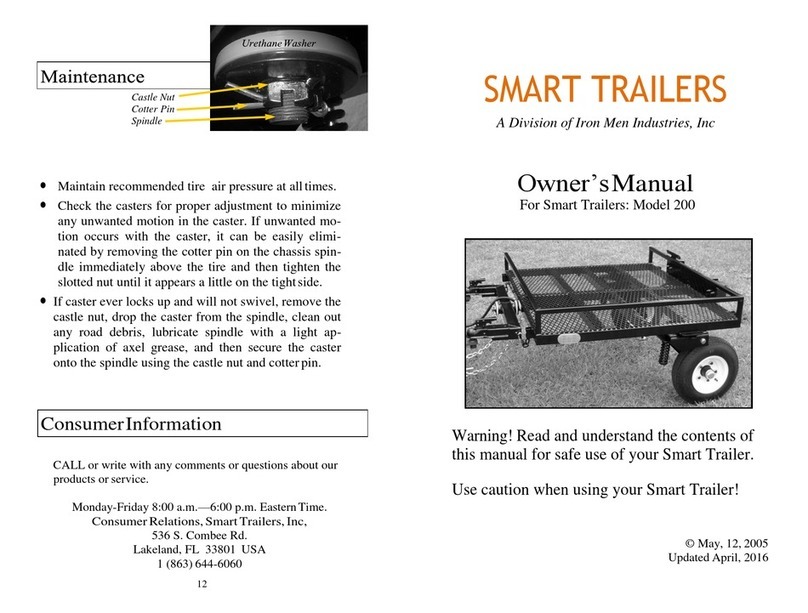
Smart Trailers
Smart Trailers 200 owner's manual

PRONAR
PRONAR T672ECO user manual

Toro
Toro Workman GTX Operator's manual
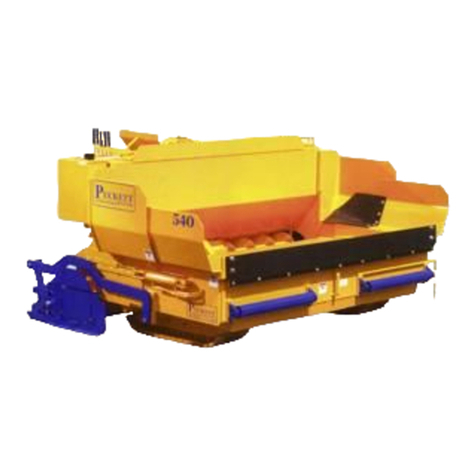
PUCKETT MFG
PUCKETT MFG 540 Operational and spare parts manual
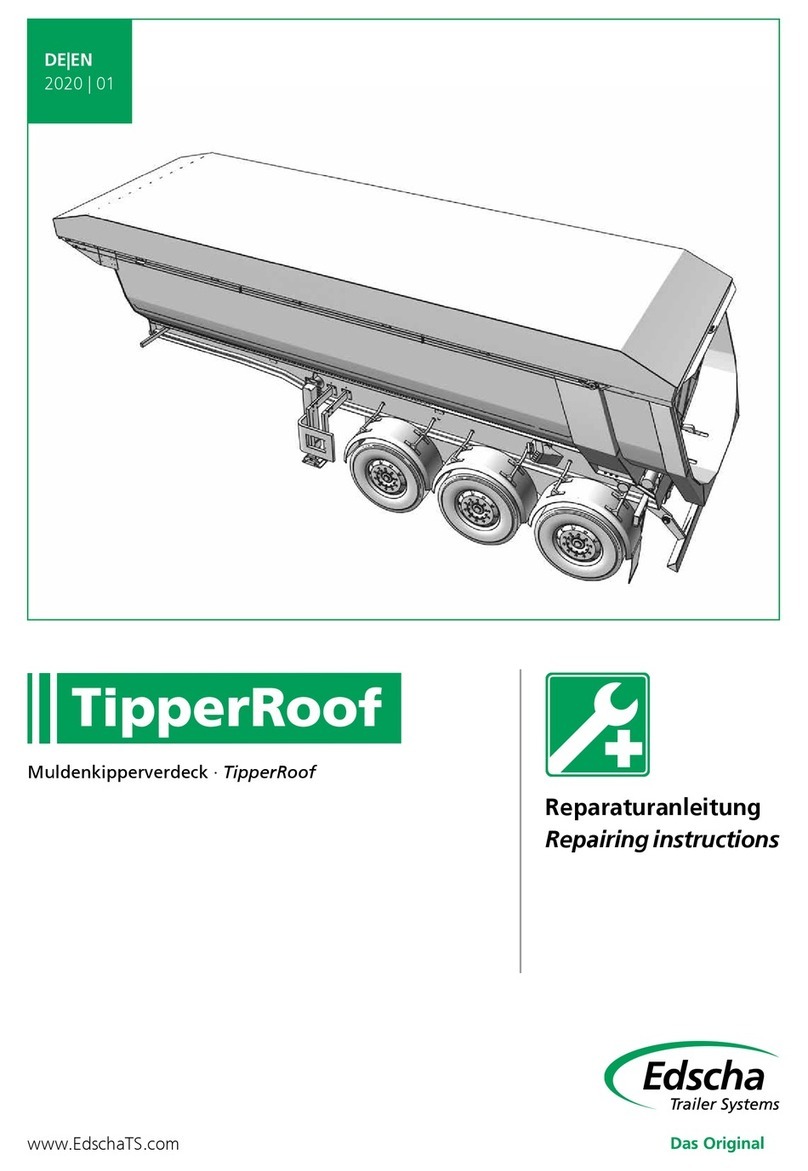
Edscha Trailer Systems
Edscha Trailer Systems TipperRoof Repairing instructions
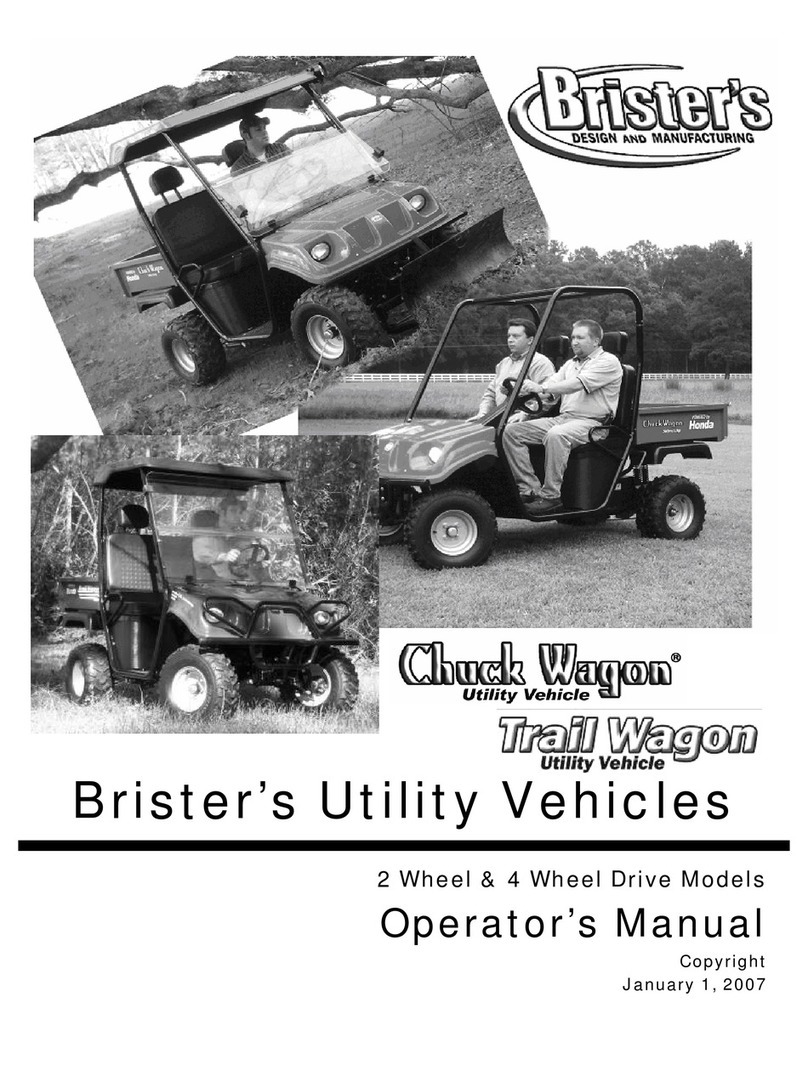
BRISTERS
BRISTERS TRAIL WAGON Operator's manual
